There's nothing quite like walking into my Lola's kitchen on a rainy Sunday afternoon and being greeted by the rich, aromatic steam of Nilagang Baka simmering on the stove. This Filipino beef soup has been my ultimate comfort food since childhood, and now that I'm a mom myself, I find myself making it whenever the weather turns gloomy or when my kids need that warm, loving hug in a bowl.
The secret to this hearty soup isn't just in the tender beef that falls off the bone or the collagen-rich broth from the tendons, it's in the patience of letting it slowly bubble away while the house fills with memories of Sunday family gatherings.
I've spent years perfecting my Lola's nilagang baka recipe, learning that the best nilaga comes from treating it like a labor of love. Watch your broth become crystal clear as you skim away the impurities, let your beef shanks simmer until they're melt-in-your-mouth tender, and add your vegetables at just the right moment so they stay crisp and bright.
Trust me, once you master this classic Filipino soup, it'll become your family's go-to comfort food, too, especially with a steaming bowl of rice and a side of patis (fish sauce).
Let me show you how to make this beloved dish exactly the way my grandmother taught me.
Jump to:
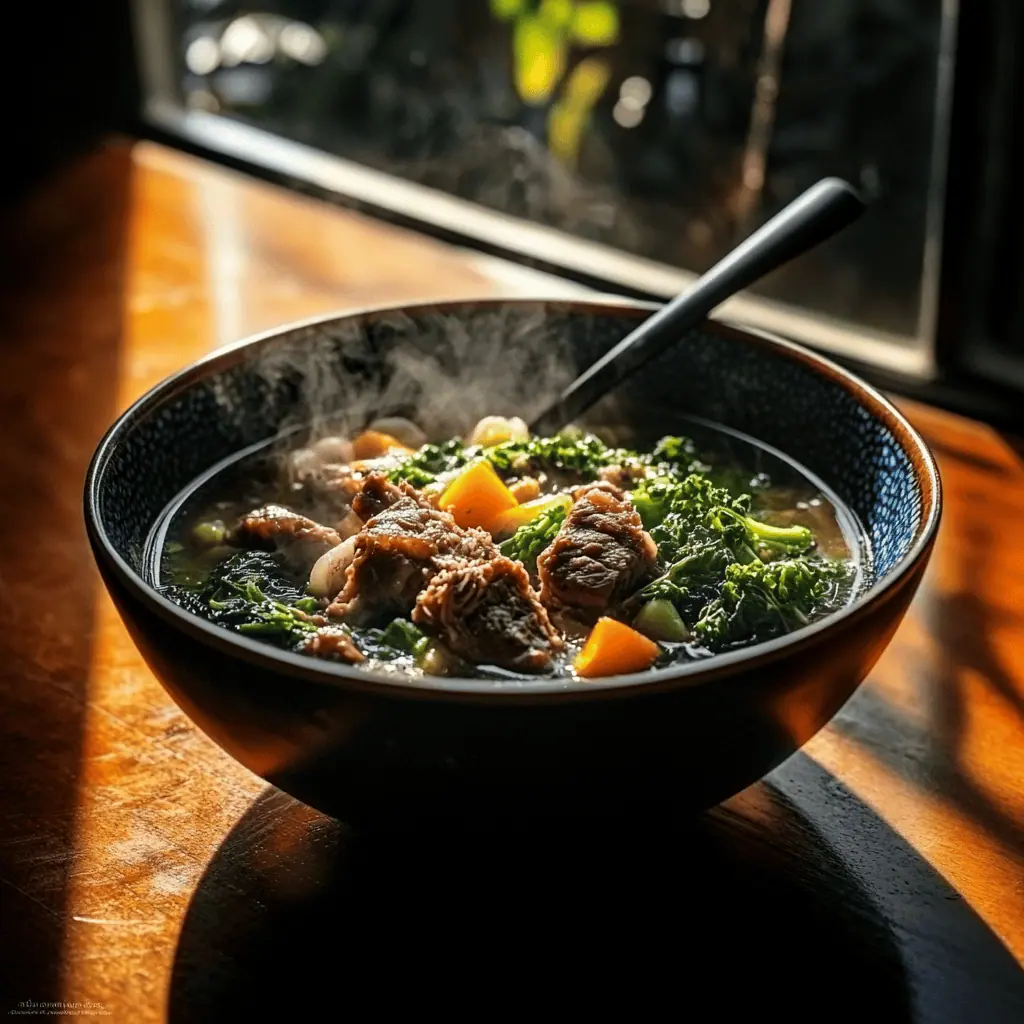
Why You'll Love This Recipe
- Rich, clear broth packed with collagen from beef tendons
- Fork-tender meat that falls off the bone
- Budget-friendly using affordable cuts of beef
- One-pot meal perfect for family gatherings
- Loaded with nutritious vegetables
- Authentic Filipino comfort food (pampainit sa tag-ulan)
- Freezer-friendly for meal prep
Ingredients
Each ingredient in Nilagang Baka serves a specific purpose to create the perfect soup. Bone-in beef shanks and tendons release collagen for a rich, satisfying broth, while whole peppercorns and onions create the aromatic base.
Fish sauce adds that distinctive umami depth that salt alone can't provide. The vegetables are carefully selected for balance: corn and potatoes add heartiness and natural sweetness, cabbage provides subtle flavor and soft texture, and green beans add color and fresh crunch.
Together, they create a complete meal that's nutritionally balanced with proteins, complex carbohydrates, and vegetables all in one pot.
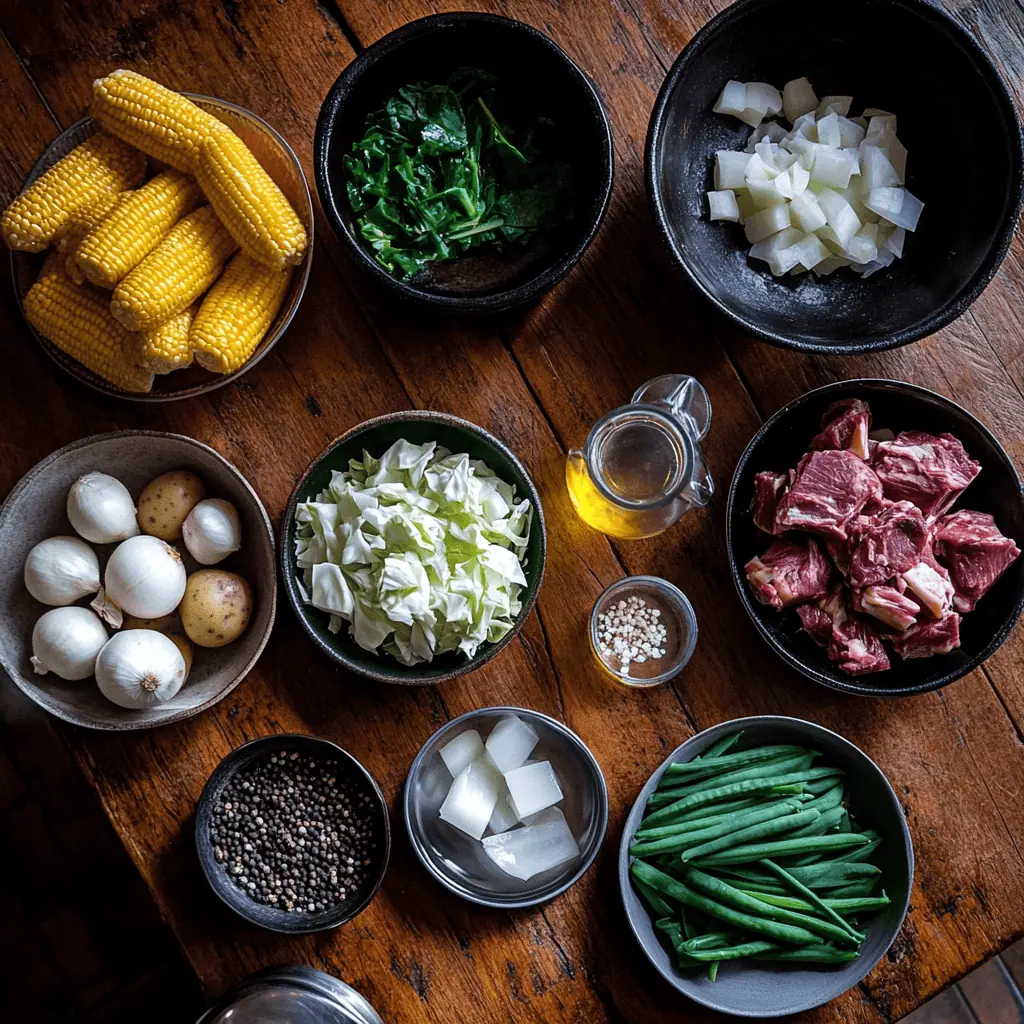
- 2 lbs beef shanks, bone-in
- 1 lb beef tendons
- 8 cups water
- 1 large white onion, quartered
- 1 tablespoon whole black peppercorns
- 2 tablespoons fish sauce
- Salt to taste
- 3 corn cobs, cut into thirds
- 2 medium potatoes, peeled and quartered
- 1 small cabbage, cut into wedges
- 12 green beans, trimmed
- Green onions for garnish
Equipment
- Large stock pot (8-quart minimum) - Provides ample space for the soup to simmer properly and develop flavor
- Sharp chef's knife - Essential for cutting vegetables and trimming meat to proper sizes
- Wooden spoon - Allows for gentle stirring without scratching your pot
- Spider strainer or skimming ladle - Critical for removing impurities for a clear broth
- Chopping board - Preferably separate ones for meat and vegetables to prevent cross-contamination
- Measuring cups and spoons - For accurate ingredient portions
- Colander - For rinsing vegetables and blanching meat
- Large serving bowl - For family-style presentation
- Small bowls - For individual servings of extra broth and fish sauce
- Kitchen thermometer - Optional but helpful to ensure proper cooking temperatures

How To Make
- Begin with the blanching step (optional but recommended). Place beef shanks and tendons in cold water, bring to a boil (212°F), then drain and rinse the meat. Clean the pot thoroughly.
- In the clean pot, combine the blanched meat and tendons with 8 cups of fresh water. Bring to a gentle boil over medium heat. Carefully skim off any scum that rises to the surface to ensure a clear broth. Add quartered onions, whole peppercorns, and fish sauce.
- Reduce heat to low (about 185°F), maintaining just a gentle simmer. Cover and cook for 2-2.5 hours, occasionally skimming any additional scum that forms. The broth should barely bubble - vigorous boiling will make it cloudy.
- Once the meat is tender and the tendons are soft and gelatinous, begin adding vegetables in stages. First add corn and cook for 5-7 minutes. Next add quartered potatoes and cook for 5 minutes. Finally, add trimmed green beans and cabbage wedges and cook for 2-4 minutes.
- Season with salt to taste. Garnish with green onions and serve hot with steamed rice and extra patis on the side.

Tips from Lola's Kitchen
- Choose beef shanks with marrow bones for an extra rich, flavorful broth
- Keep the temperature low after the initial boil—a gentle simmer produces clearer broth and more tender meat
- Add fish sauce at the beginning of cooking to allow its flavor to mellow and integrate
- Add salt only at the end after tasting the fully developed broth
- Skim the broth regularly during the first 30 minutes of cooking for crystal clarity
- Cook vegetables in stages based on density—harder vegetables first, leafy ones last
- Let the soup rest for 10-15 minutes before serving to allow flavors to settle
- Save the marrow from the bones to spread on rice or toast—it's a delicious treat
Substitutions
- Beef shanks: Beef brisket, chuck roast, or oxtail make excellent alternatives
- Beef tendons: Can be omitted, or replace with tripe for a different texture
- Green beans: Long beans (sitaw) or string beans work perfectly
- Cabbage: Baby bok choy, pechay, or Napa cabbage provide a similar texture
- White onion: Yellow or red onion will work, though with slightly different flavor notes
- Potatoes: Sweet potatoes, turnips, or taro root offer interesting variations
- Corn: Can be omitted or replaced with carrots for sweetness
- Fish sauce: Soy sauce can substitute, though it changes the flavor profile
- Peppercorns: Ground black pepper works in a pinch (1 teaspoon)
Troubleshooting
- Cloudy broth? Blanch meat first next time, or strain through cheesecloth. Try a lower simmer temperature.
- Tough meat? Continue cooking at lower temperature for 30-60 minutes more. Beef shanks need time to break down.
- Vegetables too soft? Add them later in the cooking process and maintain a gentler simmer.
- Broth too oily? Let soup cool slightly and skim fat with a spoon, or refrigerate overnight and remove hardened fat layer.
- Broth too bland? Add more fish sauce and salt gradually, tasting as you go. Consider adding beef bouillon for deeper flavor.
- Too salty? Add a quartered potato to absorb excess salt, then remove before serving. Add more water if necessary.
- Tendons still tough? They need longer cooking—sometimes up to 3-4 hours. You can pre-cook them separately.
Storage & Reheating
- Refrigerator: Store in airtight containers for 3-4 days.
- Freezer: Freeze for up to 2-3 months in freezer-safe containers.
- Best Practice: Store meat and broth together, but keep vegetables separate if freezing to prevent mushiness.
- Reheating: Warm gently on stovetop until reaching 165°F. Add fresh vegetables if originals have become too soft.
- Portion Control: Freeze in individual portions for quick lunches or dinners.
- Broth Only: The clear broth freezes beautifully and can be used as a base for other soups.
- Thaw Safely: Always thaw frozen soup in the refrigerator overnight rather than at room temperature.
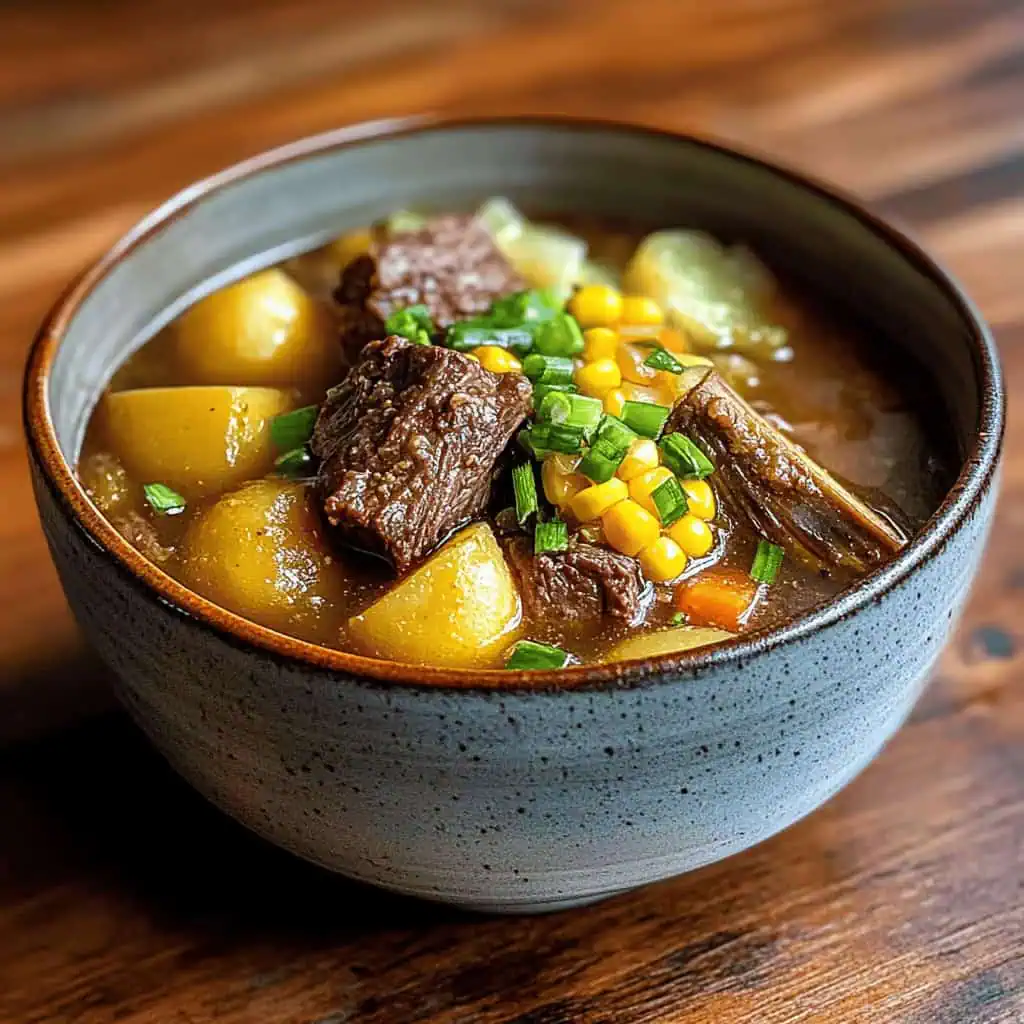
FAQ
Why should I blanch the meat first?
Blanching removes impurities and excess fat, resulting in a clearer, cleaner-tasting broth. While optional, it's highly recommended for best results.
How do I know when the tendons are done cooking?
Properly cooked tendons should be soft, slightly gelatinous, and have a melt-in-your-mouth quality. They shouldn't be rubbery or difficult to chew. This typically takes 2-3 hours of gentle simmering.
Can I use a pressure cooker or Instant Pot to speed up the process?
Yes! Cook meat and tendons on high pressure for 45 minutes (tendons) to 60 minutes (shanks), then add vegetables and pressure cook for another 2-3 minutes. The results won't be identical to the slow-cooked version but will be delicious in a fraction of the time.
My broth keeps turning cloudy. What am I doing wrong?
Rapid boiling, insufficient skimming, or stirring too vigorously can cause cloudiness. Keep your soup at a gentle simmer and skim diligently during the first 30 minutes of cooking.
Can I add other vegetables to Nilagang Baka?
Absolutely! Traditional additions include sayote (chayote), carrots, pechay (bok choy), and sometimes plantains. Add harder vegetables earlier and leafy greens at the end.
How much rice should I serve with Nilagang Baka?
A standard serving is about 1 cup of steamed white rice per person, but adjust according to preference. Some people enjoy having more broth than rice, while others prefer the opposite.
Is this soup healthy?
Yes! It's rich in protein, contains beneficial collagen from bones and tendons, and includes a variety of vegetables. The clear broth is relatively low in fat, especially if you skim it well.
Can I make this with other meats instead of beef?
Yes, similar Filipino soups include Nilagang Baboy (pork), Tinolang Manok (chicken), and even Pesang Isda (fish). The cooking techniques vary slightly, but the concept remains the same.
Related
Looking for other recipes like this? Try these:
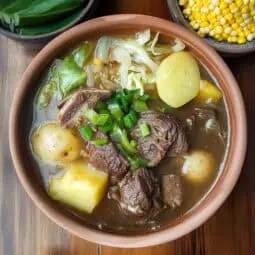
Nilagang Baka (Filipino Beef Soup)
Equipment
- Large stock pot (kaldero) for slow-simmering the soup
- Sharp knife (kutsilyo) for cutting vegetables and meat
- Wooden spoon (sandok na kahoy) for gentle stirring without scratching the pot
- Spider strainer (siyanse) for skimming impurities
- Chopping board (sangkalan) for prep work
- Measuring cups and spoons (Panukat)
- Colander (pangsala) for rinsing vegetables
Ingredients
For the Broth Base
- 2 lbs beef shanks buto-buto, bone-in
- 1 lb beef tendons litid
- 8 cups water tubig
- 1 large white onion sibuyas, quartered
- 1 tablespoon whole black peppercorns pamintang buo
- 2 tablespoons fish sauce patis
- Salt asin to taste
Vegetables
- 3 corn cobs mais, cut into thirds
- 2 medium potatoes patatas, peeled and quartered
- 1 small cabbage repolyo, cut into wedges
- 12 green beans sitaw, trimmed
- Green onions for garnish
Instructions
- Begin with the optional but recommended blanching step. Place beef shanks (buto-buto) and tendons (litid) in cold water, bring to a boil (100°C/212°F), then drain and rinse the meat. Clean the pot thoroughly.
- In the clean pot, combine the blanched meat and tendons with 8 cups of fresh water (tubig). Bring to a gentle boil over medium heat. Carefully skim off any scum that rises to the surface to ensure a clear broth. Add quartered onions (sibuyas), whole peppercorns (pamintang buo), and fish sauce (patis).
- Reduce heat to low (about 85°C/185°F), maintaining just a gentle simmer. Cover and cook for 2-2.5 hours, occasionally skimming any additional scum that forms. The broth should barely bubble - vigorous boiling will make it cloudy.
- Once the meat is tender and the tendons are soft and gelatinous, begin adding vegetables in stages. First add corn (mais) and cook for 5-7 minutes. Next add quartered potatoes (patatas) and cook for 5 minutes. Finally, add trimmed green beans (sitaw) and cabbage wedges (repolyo) and cook for 2-4 minutes.
- Season with salt (asin) to taste. Garnish with green onions and serve hot with steamed rice (kanin) and extra patis on the side.
Tips from Lola's Kitchen
- Choose beef shanks with marrow bones for richer broth
- Never let soup boil vigorously once meat is added
- Add fish sauce at the beginning but salt only at the end
- Keep broth clear by skimming regularly
- Cook vegetables just until tender-crisp to retain nutrients
Nutrition
The Story Behind Nilagang Baka (Filipino Beef Soup)
Nilagang Baka, which literally translates to "boiled beef" in Filipino, traces its roots to the Spanish colonial era in the Philippines, where it evolved from the Spanish cocido. This humble yet hearty soup showcases the Filipino talent for transforming simple ingredients into soul-warming comfort food that has sustained families for generations.
During the Spanish occupation spanning over 300 years, European cooking techniques merged with local Filipino flavors, giving birth to this beloved dish. While the Spanish cocido featured garbanzo beans and chorizo, the Filipino version adapted to local ingredients, focusing on tender beef, native vegetables, and the essential fish sauce that gives it its distinctly Asian character.
What began as a practical way to tenderize tough, affordable cuts of beef has become a cornerstone of Filipino family dining. The dish gained prominence during the American colonial period when beef became more accessible to ordinary Filipino households. The long, slow cooking process made it perfect for Sunday family gatherings, where the pot would simmer gently while family members attended church or visited with neighbors.
Today, Nilagang Baka remains a testament to Filipino food culture's emphasis on sharing and community. It's particularly cherished during the rainy season, when its steaming broth and tender meat offer comfort against the monsoon chill. From humble carinderias to modern Filipino restaurants, this dish continues to evolve while maintaining its essential character as a symbol of Filipino home cooking.
In many Filipino households, the recipe is passed down through generations, with each family adding their own subtle variations while preserving the core elements that make Nilagang Baka an enduring classic. Whether served in a simple bowl with rice and patis, or as part of a larger feast, it represents the heart of Filipino cuisine - unpretentious, nourishing, and deeply satisfying.
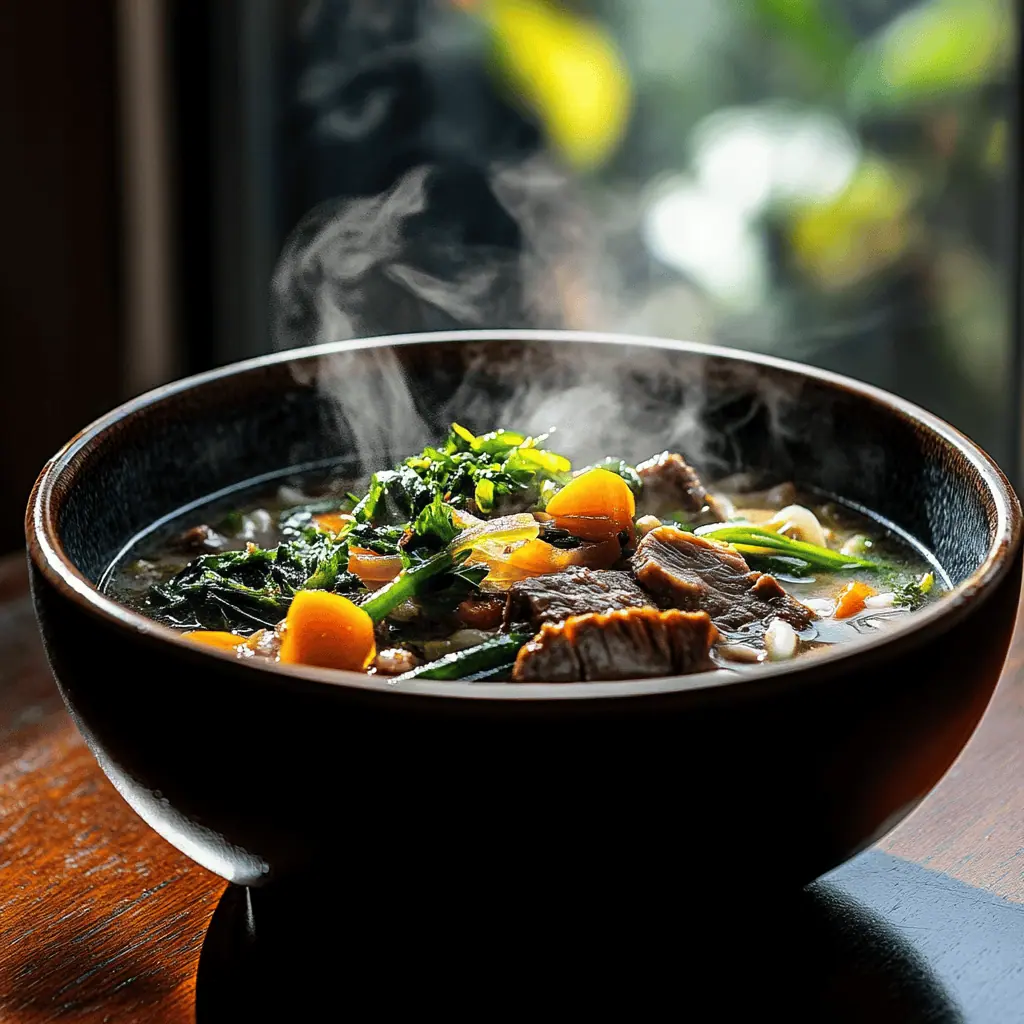







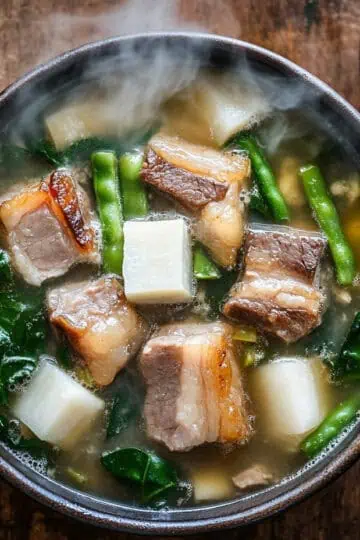

Comments
No Comments